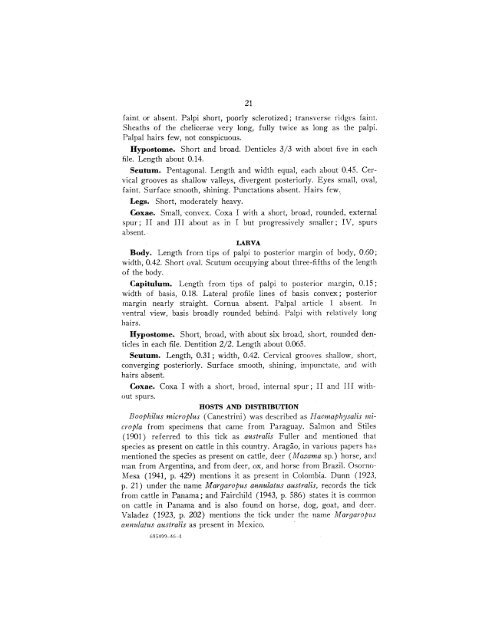The Genera Boophilus Rhipicephalus and Haemaphysalis (Ixodidae ...
The Genera Boophilus Rhipicephalus and Haemaphysalis (Ixodidae ...
The Genera Boophilus Rhipicephalus and Haemaphysalis (Ixodidae ...
You also want an ePaper? Increase the reach of your titles
YUMPU automatically turns print PDFs into web optimized ePapers that Google loves.
or absent. Palpi short, poorly sclerotized; transverse ridges faint.<br />
faint,<br />
of the chelicerae very long, fully twice as long as the palpi.<br />
Sheaths<br />
hairs few, not conspicuous.<br />
Palpal<br />
Short <strong>and</strong> broad. Denticles 3/3 with about five in each<br />
H'ypostome.<br />
Length about 0.14.<br />
file.<br />
Pentagonal. Length <strong>and</strong> width equal, each about 0.45. Cer-<br />
Seutum.<br />
grooves as shallow valleys, divergent posteriorly. Eyes small, oval,<br />
vical<br />
Surface smooth, shining. Punctations absent. Hairs few.<br />
faint.<br />
Small,-convex. Coxa I with a short, broad, rounded, external<br />
Coxae.<br />
II <strong>and</strong> III about as in I but progressively smaller; IV, spurs<br />
spur;<br />
Length from tips of palpi to posterior margin, 0.15;<br />
Capitulum.<br />
of basis, 0.18. Lateral profile lines of basis convex; posterior<br />
width<br />
nearly straight. Cornua absent. Palpal article absent. In<br />
margin<br />
view, basis broadly rounded behind. Palpi with relatively long<br />
ventral<br />
hairs.<br />
Short, broad, with about six broad, short, rounded den-<br />
Hypostome.<br />
in each file. Dentition 2/2. Length about 0.065.<br />
ticles<br />
Length, 0.31;width, 0.42. Cervical grooves shallow, short,<br />
Scutum.<br />
posteriorly. Surface smooth, shining, impunctate, <strong>and</strong> with<br />
converging<br />
absent.<br />
hairs<br />
Coxa I with a short, broad, internal spur; II <strong>and</strong> III without<br />
Coxae.<br />
spurs.<br />
AND DISTRIBUTION<br />
HOSTS<br />
microplus (Canestrini) was described as<br />
<strong>Haemaphysalis</strong> n4i-<br />
<strong>Boophilus</strong><br />
from specimens that came from Paraguay. Salmon <strong>and</strong> Stiles<br />
cropla<br />
referred to this tick as australis Fuller <strong>and</strong> mentioned that<br />
(1901)<br />
from Argentina, <strong>and</strong> from deer, ox, <strong>and</strong> horse from Brazil. Osornoman<br />
(1941, p. 429) mentions it as present in Colombia. Dunn (1923,<br />
Mesa<br />
21) under the name Mrgaropus ann, ulatus australis, records the tick<br />
p.<br />
cattle in Panama; <strong>and</strong> Fairchild (1943, p. 586) states it is common<br />
from<br />
cattle in Panama <strong>and</strong> is also found on horse, dog, goat, <strong>and</strong> deer.<br />
on<br />
(1923, p. 202) mentions the tick under the name Margaropus<br />
Valadez<br />
21<br />
Legs.<br />
Short, moderately heavy.<br />
absent.-<br />
LARVA<br />
Length from tips of palpi to posterior margin of body, 0.60;<br />
Body.<br />
0.42. Short oval. Scutum occupying about three-fifths of the length<br />
width,<br />
the body.<br />
of<br />
as present on cattle in this country. Arago, in various papers has<br />
species<br />
the species as present on cattle, deer (Maa.ma sp.) horse, <strong>and</strong><br />
mentioned<br />
annulatus australis as present in Mexico.<br />
695499-46-4

















